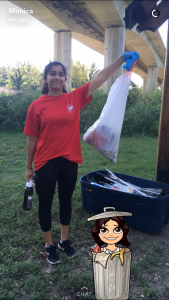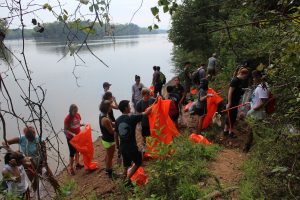A few weeks ago, Monica and I took a trip down to Belle Isle to participate in a trash cleanup. Dressed in our fashionable plastic gloves and iridescent clear plastic bags—surrounded by older people, very young people, and no college people—we set down the road to trash heaven. However, as we went farther down the trail and into the forest, all we seemed to be finding was cigarette butts and tiny wrappers. Where was all the trash?
We thought back to the Dutch Gap trash clean up and recalled the bags upon bags we collected of trash and recyclables. There was garbage in places you could hardly see from the trail. What was different? Why was Belle Isle relatively cleaner?
The more I thought about it, the more I realized; Belle Isle is a place people associate and identify with. It is a place that means something to the locals. At any given time, you can find Richmonders taking their kids on walks to explore the outdoors, or people sitting on rocks having a picnic. The trail itself is a “1.8 mile heavily trafficked loop” for joggers and bikers (alltrails.com). This area is considered a local favorite.
Therefore, compared to the trails at Dutch Gap, Belle Isle is a more populated area and people have more of a motivation to keep it clean. In fact, so many people stopped what they were doing and commended Monica and I for our work, which was very unexpected. One lady went on to talk about how stunning this place used to look and how she hopes to see it in that state again soon. People have seen what Belle Isle could be and want to bring it back to that standard.
This seems to correlate with Forsyth’s Awareness-Appraisal model. People consider this area of the James River Watershed to be degraded—they are aware of it. Along with the awareness of the threat of trash and the appraisal of the degree of pollution, there is an increase in an individual’s willingness to want to change the surroundings. This concept is lacking at Dutch Gap due to its much more isolated position. In order to increase awareness and decrease the pollution there, more people need to be exposed to the Gap’s overgrown trails. Essentially, spreading awareness is the only way action will be taken, and will want to be taken.


